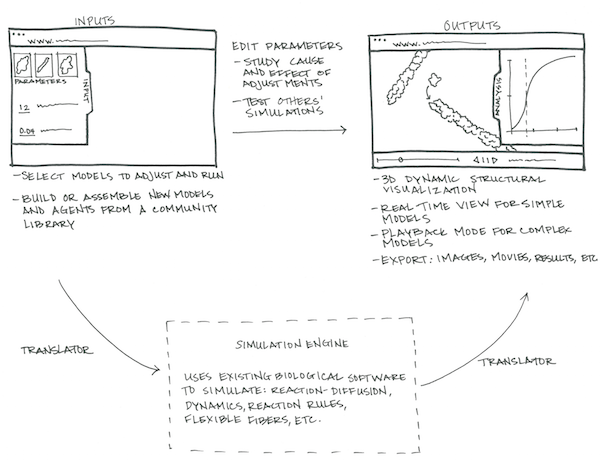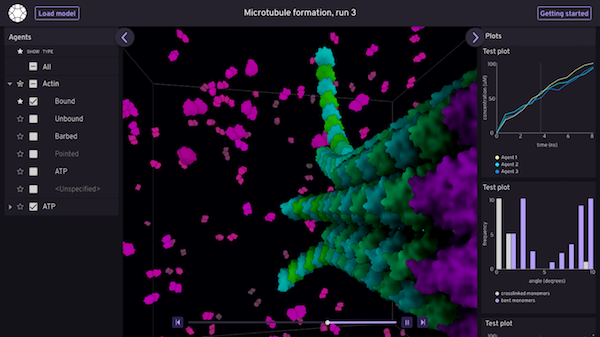Project
Design zero to one visualization product. Simularium is a biological simulator to allow users to model cell processes at the tissue, cell, and molecular scales at the Allen Institute for Cell Science to share their science with users around the globe to amplify their research and help educators to teach cell biology.My Role
Design Lead, Research LeadUsers
Global audience of lab researchers, academic, and curious lay users who wish to share and learn from molecular simulationsCollaborators
5 Engineers, 2 Cell Biologists, Scientific AnimatorSituation
- Some biological phenomena cannot be observed. Researchers must use simulation to run experiments to test hypotheses.
- The simulation tools available required more processing power than many users have. These downloadable desktop apps usually required coding skills, excluding laboratory users who are not computational biologists.
- Simulations are often produced to be used by its developer, are not scalable, are not easily shareable or reusable.
- Cell biology is a complex topic that is challenging to teach and learn. Simulation models enable users to visualize processes to better understand what is happening at the cellular and molecular levels of scale.
- Frequently, simulation tools were either homegrown, or they were difficult to use with outdated interfaces.
Landscape of other biological simulator products

Examples of other biological simulators. These available tools are difficult to use and may require scientists to be programmers. Image credits: Gillespie (Systems Biology Workbench), Kappa Language (Harvard University), and Spring SaLaD (UConn Health).
Goals
- Design and build our open scientific nonprofit tool to the same design standards of commercial software.
- Build a free, web-based, multi-scale 3D simulation tool that supports use cases across computational, laboratory, and educational audiences.
- Support simulations built with others’ libraries.
- Build a community of users based on crowdsourced data to support open science.
Approach
- Learn all I could about cell biology and simulation via interviews and personal exploration
- Study the competitor landscape
- Collaborate with team to devise the best possible solution and break project into meaningful milestone releases
- Sketch ideas
- Collect feedback
- Build wireframes
- Test designs with users
- Iterate and build interactive prototypes
- Test designs with users
- Visual design and iteration
Activities
- UX design and research
- Learning
- Interviews
- Sketching
- Design in Sketch
- User studies
- Wireframes
- Interactive prototyping in Principle
- Visual design
- Develop design library and share via Zeplin

Initial concept sketch. This simple sketch has changed and evolved with iteration. However, its basic concept has guided future versions of Simularium as the design moves through fidelities.
Interactive prototype. This prototype gave users a sense of Simularium’s capabilities. It includes sliding drawers, drag-and-drop interaction, mocked-up text input, and more.
Results
- Designed a new way of building and sharing biological simulations
- Developed a look and feel for Simularium, which will be carried across other tools in the ecosystem
- Supported library of simulations as well as user data

Full-color screen. I iterated on the design while focusing on functionality first, and moved forward through fidelities. Here, I added visual design and polish. The central viewport displays an early version of simulation renderings.
Live site. The first version of Simularium launched. This is a 3D simulation model of the SARS-COV-2 virus. You can try Simularium here.
Impact
- Supported open science by providing a means to make biological simulation more accessible to scientists around the world
- Produced materials that make complex biological topics easier to teach and learn
- Helped shape the way scientists share and collaborate, accelerating and democratizing research
Reflection
What I learned and practiced:- How to understand these users' specific needs
- How to quickly and deeply gain domain knowledge in a topic outside my expertise
- How to design for multiple audiences
- How to present a complex tool in the simplest, cleanest possible way
- How to scope a large project into manageable pieces
- How to gain trust of users who are domain experts